#regalecus glesne
Text
Wet Beast Wednesday: oarfish
It's the first Wet Beast Wednesday of the year. A year is a long time, and do you know what else is long? Oarfish! (A+ segue right there). Oarfish are long, skinny, and large fish of the family Regalecidae known for their odd appearances. There are three known species of oarfish in two genera: Agrostichthys parkeri, Regalecus russelii, and the most famous: Regalecus glesne.
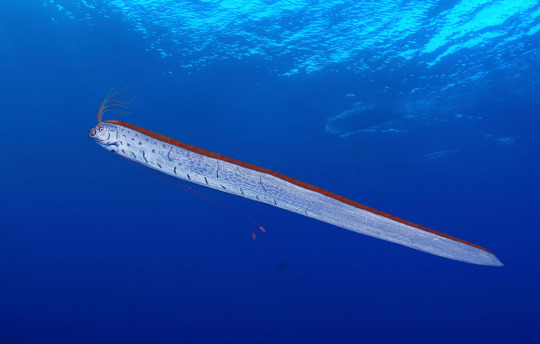
(image id: a giant oarfish swimming. It is a long, serpentine fish with silvery skin ands multiple black patches. A short, red dorsal fin runs down its back and a crest of fin rays is on the head. end id)
All oarfish are poorly understood due to their deep-sea habitats leaving it hard to study them in the wild. As such, most information about them is known from rare wild sightings and carcasses. Adults live between 250 and 1000 meters (660 to 3300 ft) down, but larvae are occasional juveniles are found near the surface. Living oarfish that end up near the surface are likely to quickly die of depressurization. All species are long, slender, and scaleless, with elongated fin rays at the leading edge of the dorsal and pectoral fins that result in training crests. Their mouths are small and usually toothless (though some have been found with vestigial teeth) and can protrude outward. This protrusion creates suction, which the oarfish uses to draw food into its mouth. Its diet consists of zooplankton, primarily krill and shrimp, but also jellyfish, squid, small fish, and other crustaceans. They lack swim bladders and likely have to actively swim to maintain their position in the water column. Oarfish are believed to use two kinds of locomotion. They can undulate their whole body or by holding the body straight and moving only the long dorsal fin. Regardless of method, oarfish are not strong swimmers. Many of the vertebrae in the tail are hyper-ossified, meaning they have excess bone growth. This is believed to provide support for the tail as it moves and prevent fractures. It also likely helps control buoyancy. In some specimens, the tail appears to be blunted. This is speculated to be the result of self-amputation. The hypothesis is that the oarfish can drop part of its tail to escape predators. The predator would then go after the tail rather than expend more energy attacking the fleeing fish. The ability to lose a body part like this is called autotomy. While some animals who practice autotomy can regrow the lost body part, there is no evidence that oarfish can regrow their tails. Little is known about oarfish reproduction, but they are presumed to reproduce externally and provide little or no parental care. Larval oarfish float below the ocean's surface and feed on plankton. Juvenile oarfish have occasionally been found swimming at shallow depths. It is not clear how long oarfish development takes or at what point they descend into the deep sea. The lifespan is also unknown. Footage of oarfish in their natural habitat shows that they spend a lot of their time positioned vertically in the water, with their heads facing the surface. This would help them spot prey silhouetted against the sunlit surface of the water.

(image id: a closeup of the head of a giant oarfish lying on sand. The head is indistinct from the body. It has a large, silver eye with black pupil. The mouth is oriented vertically, making it look very odd compared to most fish mouths. The rest on its head and elongated pectoral fin rays are visible. End id)

(image id: four pictures of larval Regalecus russelii. It is of a similar body shape to an adult, but shorter and without pigment. The first fin rays for the head and fin crests are visible. End id. source)
The smallest of the oarfish is Agrostichthys parkeri, sometimes called the streamer fish. Small is a relative term as it can grow up to 3 meters (9.8 ft) long. Unlike the other known oarfish, it has hard nodules on its skin that may help with defense. A. parkeri is the least-well known of the oarfish. Only seven specimens have ever been examined. They have only ever been found in the southern Pacific ocean. The next largest is Regalecus russelii, Russell's oarfish. It can reach 5.4 meters (18 ft) long and is found worldwide along the equator. The largest and most famous species is Regalecus glesne, the giant oarfish. At recorded sizes up to 8 meters (26 ft) and 270 kg (600 lbs) and unconfirmed reported sizes up to 11 meters (36 ft), the giant oarfish is the longest bony fish alive today. Truley the longest of bois. They are found worldwide between the equatorial and polar regions.
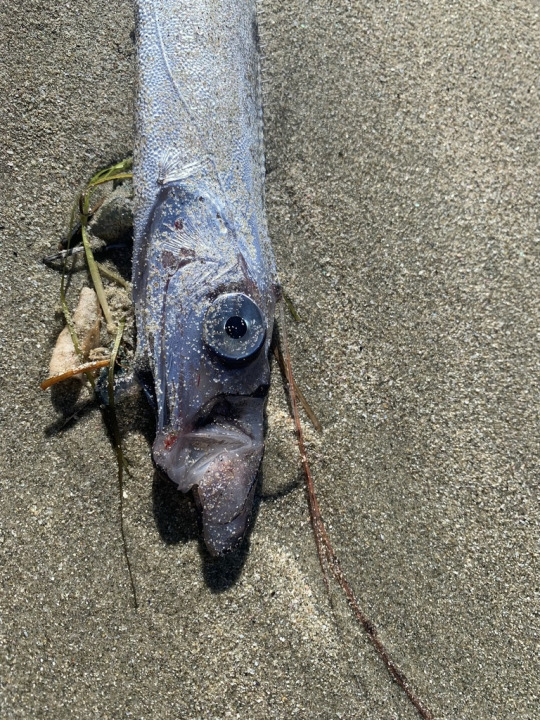
(image id: the head of a deceased Agrostichthys parkeri lying on sand. Its head is longer than that of the giant oarfish and the open mouth appears as an extension of the head. end id)

(image id: a juvenile Regalecus russelii found in the great barrier reef. It looks similar to the giant oarfish, but is considerably smaller and its body is a pale blue. end id)
Due to their long, slender bodies, relative rarity, and extreme size, sightings of oarfish are speculated to have been responsible for many sightings of sea serpents. While most sea serpents were described as terrifying monsters that would attack ships, oarfish are completely harmless to humans. The reverse is not the case, as oarfish are occasionally caught as bycatch. There is no commercial fishery for oarfish as their meat is too poor quality to be used as food. One common name for oarfish is "king of herrings". This came from early reports of them apparently swimming amongst schools of herring, with sailors assuming the oarfish were leading the herring. In Japanese mythology, oarfish are known as "Ryūgū-no-tsukai" which translates to "messengers from the palace of the sea god". A bit of Japanese folklore considers oarfish to be harbingers of earthquakes. There is no scientific evidence for any relationship between oarfish and earthquakes, but the belief got boosted after mass strandings of Russel's Oarfish happened in early 2010 and a massive earthquake occurred in 2011. Little is known about the conservation needs of all species of oarfish and no species currently has legal protection.

(image id: 17 people (with more in the background) holding up a deceased giant oarfish to show its scale. end id)
#wet beast wednesday#oarfish#long boi#giant oarfish#Agrostichthys parkeri#Regalecus russelii#Regalecus glesne#fish#fishblr#fishposting#marine biology#biology#zoology#ichthyology#animal facts#long post#image described#cw dead animal
346 notes
·
View notes
Text
BIG FUCKING FISH 4 YEAHHHHHHHH



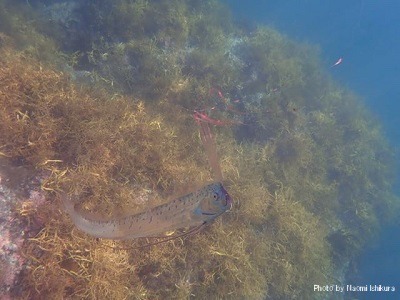
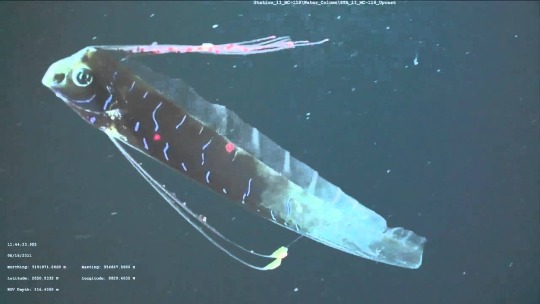


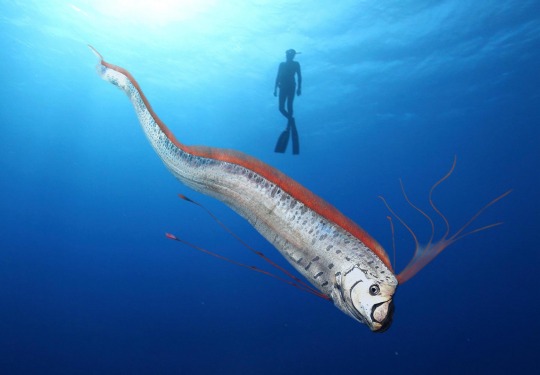
giant oarfish - regalecus glesne
#the worlds longest normal girl#giant oarfish#oarfish#regalecus glesne#fishposting#big fucking fish#marine biology#bony fish#if any of these images are wrong pls lmk!! it was so hard to find giant oarfish photos where it was alive ToT
26 notes
·
View notes
Text
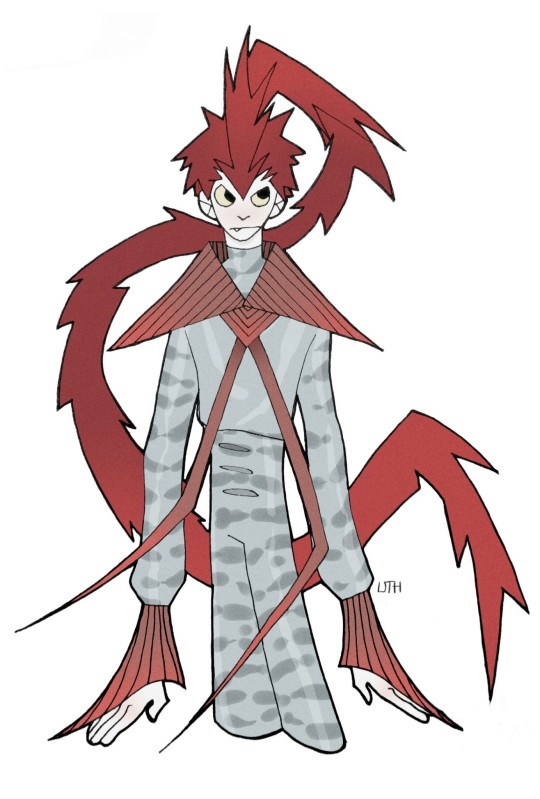

#humanization#giant oarfish#regalecus glesne#oarfish#marine biology#fish#artists on tumblr#art#illustration#drawing#humanisation
9 notes
·
View notes
Note
His name is penis and he was born without a brain.
Say something nice to him.
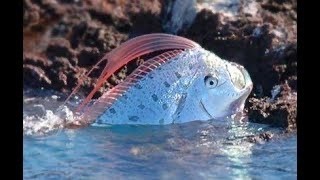
Hello Penis,
What you're missing in brains you make up for in 1,100 CM (36 FT) OF PURE FISH

Regalecus glesne or Oarfish
3K notes
·
View notes
Text
🐟 Fishuary 2024 Day Thirteen: Big Fish 🐟

Very few fish are as big as the biggest bony fish in the world, giant oarfish, Regalecus glesne! Let's draw some morefish!
@fish-daily
90 notes
·
View notes
Text

🇲🇫 Heyy
J'étais assez occupée par les cours dernièrement mais j'ai malgré tout réussi à prendre le temps de dessiner ces petits croquis 😌 (les combinaisons de plongée sont super satisfaisantes à dessiner aaaaaaaaaah)
J'ai été inspirée par le travail de @/manabukoga_underwater (sur Instagram) pour trois des poses (cf. photos de référence) ✨️
Concernant les mediums utilisés, il y a (évidemment) l'aquarelle mais j'ai également essayé pour la première fois des feutres à l'acrylique et j'adore leur sensation et leur rendu super doux !
Et parce que je suis une nerd, j'ai voulu ajouter quelques animaux marins donc remerciements spéciaux à la murène ruban (Rhinomuraena quaesita), au régalec (Regalecus glesne), à l'otarie de Californie (Zalophus californianus), au requin-tigre (Galeocerdo cuvier) et à la méduse aurélie (Aurelia aurita)
Je suis assez contente de ces quatre dessins !
_ _ _ _ _ _ _ _ _ _ _ _ _ _ _ _ _ _ _
🇬🇧 Heyy
I've been quite busy with classes lately but I still managed to take some time to make these little sketches 😌 (wetsuits are so satisfying to draw aaaaaaaaaah)
I've been inspired by the work of @/manabukoga_underwater (on Instagram) for three of the poses (cf. photo references) ✨️
Regarding the media I used, there's (obviously) watercolour but I also tried acrylic markers for the first time and I absolutely love how smooth they are!
And because I'm a nerd, I wanted to add some sea animals so special thanks to the ribbon eel (Rhinomuraena quaesita), the giant oarfish (Regalecus glesne), the California sea lion (Zalophus californianus), the tiger shark (Galeocerdo cuvier) and the moon jellyfish (Aurelia aurita)
I'm quite happy with all four of them!
Close ups and references:
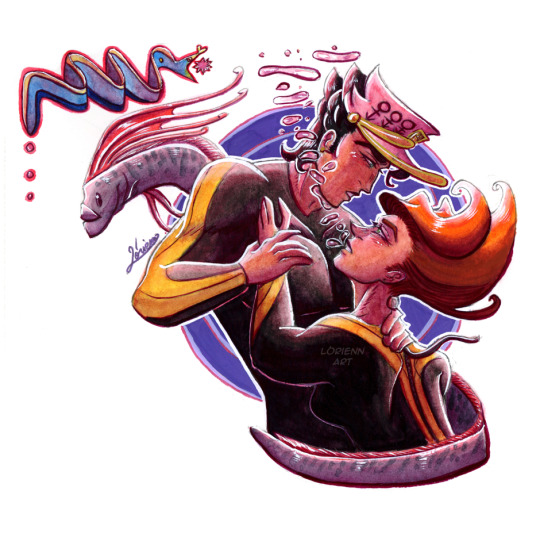



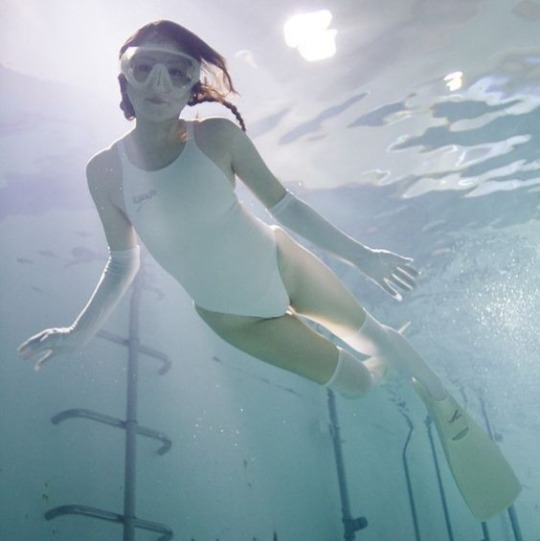


#artists on tumblr#watercolour#watercolor#acrylic markers#sea animals#jjba#jojos bizarre adventure#jojo no kimyou na bouken#jojo's bizarre adventure#jotaro kujo#jotawife#mrs kujo#jolyne's mom#jolynes mom
24 notes
·
View notes
Text
Apocalypse, my kinitopet oc ll
Regalecus glesne









24 notes
·
View notes
Photo


Giant oarfish (Regalecus glesne) charm by Colorata
378 notes
·
View notes
Text
day 47, 10/03/24 - fish of the day is the giant oarfish (Regalecus glesne)

7 notes
·
View notes
Note
7, 16, 21 for the ask meme
7. What animal do you look forward to seeing when you visit an aquarium?
The ones that I've only seen on documentaries, tv or videogames. Some that come to mind are Mola mola, Arapaima gigas, Regalecus glesne, and Cheilinus undulatus.
16. Thoughts on mint chocolate chip?
Not particularly fond of mint flavors. I only like it on my soup.
21. A number that weirds you out?
I'd say ∞ but I checked to be sure and it's not a number, so I'm saying π. It's fucked up that it just goes on forever.
2 notes
·
View notes
Text
Oarfish are Lanky Fellas

The Oarfish, or Regalecus glesne, is a very long species of bony fish. These guys get absolutely huge, ranging from 8-11 meters in length.
Oarfish are incredibly majestic, but also have really funny looking faces. The duality is truly fascinating.
Weirdly enough, despite looking kind of like dragons, oarfish have no scales. Instead, they're covered in a slimy membrane.
Another odd thing about oarfish is that they often swim with their heads facing upwards. I believe it would be quite frightening to stare into the abyss of the deep only to find another pair of eyes staring right back at you. It's creepy!
Thankfully, they don't eat humans.
youtube
Sources: https://www.marinebio.org/species/oarfishes/regalecus-glesne/
0 notes
Text
Blog 7: Production process
by Anna Mini Jayan
Once we decided on an idea and refined it according to suggestions, we split our work amongst ourselves. My part was to model and animate jellyfish, fishes, and oarfish. For the process of animating, I decided to create blend shapes of the jellyfish using layers in Zbrush, export them to Maya, and animate them there. After animating them in Maya, I exported them as FBX files with baked animation to import them into the Unreal engine.
youtube
Reference for the animation

I started by collecting references for the jellyfish animation since it looked like it was the hardest to tackle. I found a reference for the animation on YouTube and gathered a few images of the jellyfish. The animation of underwater creatures in the movie Little Mermaid, specifically in the song, Under the Sea also helped as a reference for the animations. I also gathered reference images for the rest of the fish.
youtube
I started by modeling the jellyfish from scratch in Zbrush. I went through some different iterations before I finally settled on a base. I had also considered animating the main body and tentacles as separate objects but decided not to do it since I was advised that it would be better to make it a single model. After I made the low poly mesh, I sculpted details onto it and textured it in substance painter. I made three colour variations of the jellyfish based on some reference images I found. During the animation part of the jellyfish, it took me quite some time to get the blend shapes right. I sent a video of the animations that I made and got them approved by the other group members.

After I was done with the jellyfish animations, I started working on the fish and an oarfish. For the fish, I downloaded a free tuna fish model by Goldenztuff on cgtrader.com. The fish came with animations but unfortunately, it was not working so I animated it using blend shapes as well. For the oarfish, I used the fish head of the tuna fish and modeled the rest of the body. The models were all retopologised and uv unwrapped within Zbrush. I tried using the sine deformer for the oarfish animation but I later realised that animations using deformers do not work in the Unreal engine, so the oarfish also ended up being animated using blend shapes. Unfortunately, the fishes ended up not being used in the final artefact.

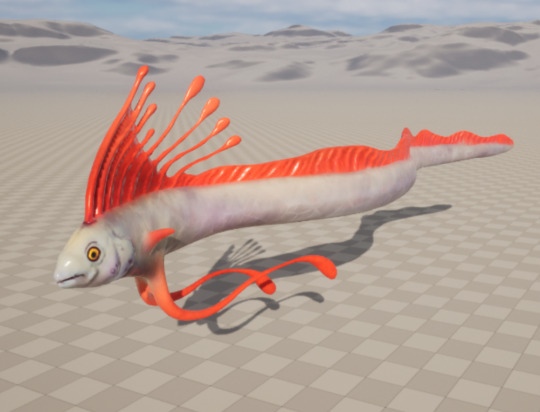
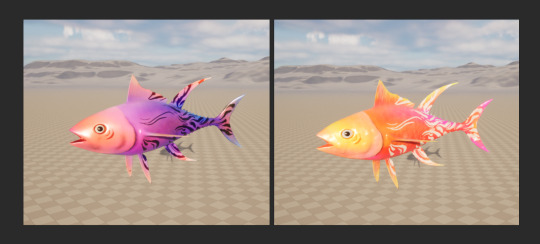

https://www.cgtrader.com/free-3d-models/animals/fish/tuna-fish-9f41924a-83d4-478e-a8e9-370946f141b3 - Tuna fish
My teammates are also enthusiastic and fall into their roles well. We all collaborated effectively and managed to successfully implement our responsibilities. Everyone respected each other's opinions and was also willing to accept them. Overall, the project provided me with valuable experience on how to interact and work with other people on a project while successfully navigating it. This experience will help me adjust well to a professional work environment in the future.
Bibliography
Dan90266. (2005) Chrysaora fuscescens, Wikipedia. Available at: https://en.wikipedia.org/wiki/Jellyfish#/media/File:Jelly_cc11.jpg
Peta. (n.d) phone-wallpaper-g0f1176169_1920.jpg, Peta.org. Available at: https://www.peta.org/features/fascinating-facts-about-jellyfish/
BrokenDiver. (2019) Wendy Northway, Wikipedia. Available at: https://www.discoverwildlife.com/news/jellyfish-beneficial-to-marine-life
Zee Media Bureau. (2016) Oarfish, Wikipedia. Available at: https://zeenews.india.com/news/eco-news/the-lesser-known-facts-about-oarfish_1871922.html
Fany001. (2013) Regalecus glesne Oarfish, Deviantart. Available at: https://www.deviantart.com/fany001/art/Regalecus-glesne-Oarfish-346135642
Moka Studio (2012) Jellyfish 3D animation [YouTube Video]. Available from: https://youtu.be/4Tq5O3Lkh88?si=jetCe-GqqpVvUwnD
DisneyMusicVEVO (2023) Daveed Diggs, Cast - The Little Mermaid - Under the Sea (From "The Little Mermaid") [YouTube Video]. Available from: https://youtu.be/Wbv_huklr5E?si=WhjDFiLh2BlZs9y8
goldenztuff (2022) Tuna Fish Animated Free low-poly 3D model, cgtrader. Available from:https://www.cgtrader.com/free-3d-models/animals/fish/tuna-fish-9f41924a-83d4-478e-a8e9-370946f141b3
0 notes
Text
0 notes
Text
Do you guys (gn) know about the king of herrings (Regalecus glesne)? It's the longest bony fish in the world. It swims like an eel and it just sits vertically in the middle of school of herrings (hence the name).
0 notes
Text
Daily fish fact #210
Oarfish!
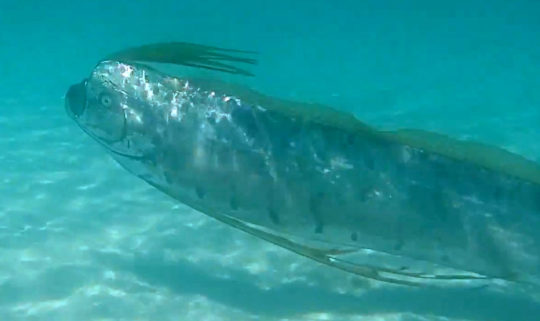
"Oarfish" actually refers to three different species of oarfish! These are Russell's oarfish (Regalecus russelii), giant oarfish (Regalecus glesne) and streamer fish (Agrostichthys parkeri).
#despite the pic these guys are mostly deep sea fish btw#fish#fishfact#fish facts#biology#zoology#aquatic#fishblr#marine biology#marine life#sea creatures#sea life#marine animals#oarfish
78 notes
·
View notes
